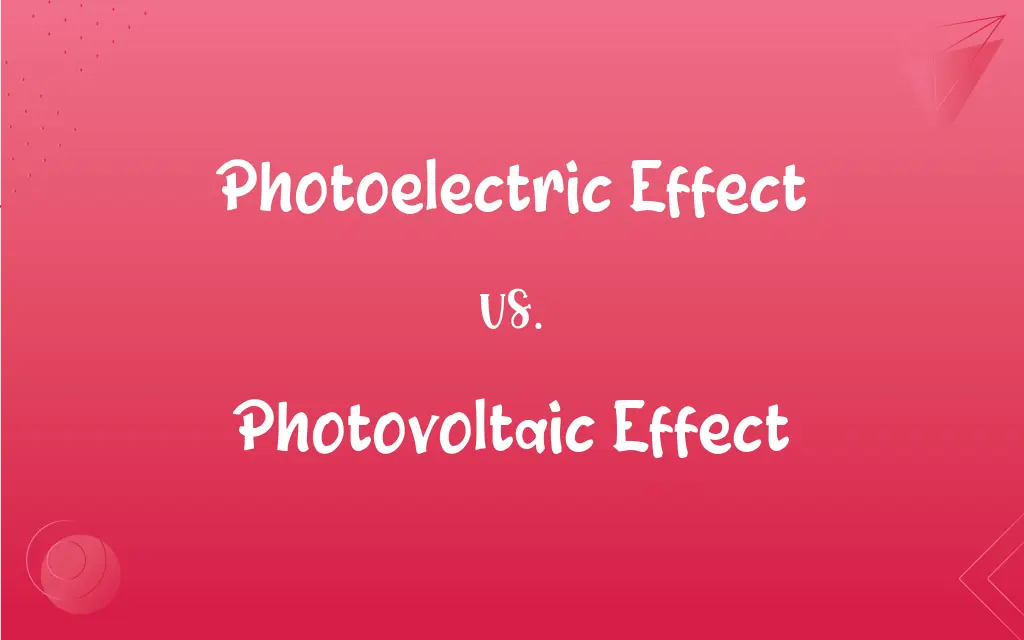Photoelectric Effect vs. Photovoltaic Effect: What's the Difference?
Edited by Janet White || By Harlon Moss || Updated on October 16, 2023
Photoelectric effect: ejection of electrons by light. Photovoltaic effect: electricity generation by light.

Key Differences
The photoelectric effect involves the ejection of electrons from a material when light hits it, typically observed in metals. Conversely, the photovoltaic effect refers to the creation of voltage or electric current in a material upon exposure to light, usually in semiconductors.
Einstein's explanation of the photoelectric effect was groundbreaking, highlighting the particle nature of light through photons. The photovoltaic effect, however, is utilized in solar panels, which convert sunlight into electricity, exploiting the properties of semiconductor materials.
The photoelectric effect demonstrates a threshold frequency, below which no electrons are ejected, regardless of light intensity. In contrast, the photovoltaic effect in solar cells generates electricity proportionally to the sunlight's intensity, without a threshold frequency for operation.
The photoelectric effect has been pivotal in quantum mechanics' development, emphasizing light's particle attributes. The photovoltaic effect focuses on the practical application of light's energy conversion into electricity, critical in renewable energy research.
Instruments like photomultiplier tubes exploit the photoelectric effect for their function, detecting and amplifying light signals. In contrast, the photovoltaic effect is the working principle behind photovoltaic cells, the fundamental components of solar panels used in sustainable energy production.
ADVERTISEMENT
Comparison Chart
Nature of Effect
Emission of electrons
Generation of voltage/current
Material Used
Typically metals
Usually semiconductors
Application
Scientific (e.g., electron emission studies)
Commercial (e.g., solar panels)
Relation to Light's Frequency
Has a threshold frequency
No threshold frequency; continuous operation
Contribution to Science
Quantum mechanics' development
Renewable energy advancements
ADVERTISEMENT
Photoelectric Effect and Photovoltaic Effect Definitions
Photoelectric Effect
The photoelectric effect is the phenomenon that describes how electrons are released from a surface upon light exposure.
Albert Einstein won the Nobel Prize for explaining the photoelectric effect.
Photovoltaic Effect
The photovoltaic effect refers to the phenomenon where light causes voltage to arise between two different materials.
Silicon is a commonly used material in harnessing the photovoltaic effect for electricity production.
Photoelectric Effect
The photoelectric effect is the process where light energy is absorbed by electrons in a material, causing them to be emitted.
The photoelectric effect has a threshold frequency below which no electrons are released.
Photovoltaic Effect
The photovoltaic effect is the generation of voltage or electric current in a material upon exposure to light.
Solar panels use the photovoltaic effect to convert sunlight into usable electricity.
Photoelectric Effect
The photoelectric effect refers to the ejection of electrons by a substance exposed to electromagnetic radiation.
Photomultiplier tubes rely on the photoelectric effect to detect light particles.
Photovoltaic Effect
The photovoltaic effect is the creation of an electric current in a substance when it is exposed to light.
The photovoltaic effect is the foundational principle behind solar energy technology.
Photoelectric Effect
The photoelectric effect is the quantum mechanical phenomenon of electron release from a material due to light absorption.
The photoelectric effect is evidence of light's particle nature, as demonstrated by photon interactions.
Photovoltaic Effect
The photovoltaic effect involves converting light energy into electrical energy through the creation of a voltage difference.
The efficiency of the photovoltaic effect in solar cells determines the overall energy output.
Photoelectric Effect
The photoelectric effect is the emission of electrons from a material when struck by light.
The photoelectric effect explains why certain metals eject electrons when exposed to sunlight.
Photovoltaic Effect
The photovoltaic effect is the process where photons of light excite electrons into a higher state of energy, creating electricity.
Research in enhancing the photovoltaic effect is crucial for sustainable and renewable energy advancements.
FAQs
How does the photovoltaic effect work?
It generates voltage/electric current when light hits a semiconductor.
Why is the photoelectric effect important?
It supports quantum theory by showcasing light's particle nature.
Does the photoelectric effect have any threshold?
Yes, a minimum light frequency is needed to eject electrons.
What is the photoelectric effect?
It's the ejection of electrons from a material upon light exposure.
Can the photovoltaic effect be improved?
Yes, through material science and engineering advancements.
Is the photoelectric effect instantaneous?
Yes, electron ejection occurs immediately upon light exposure.
Did the photoelectric effect contribute to any major scientific theories?
Yes, it was crucial in the development of quantum mechanics.
Who explained the photoelectric effect?
Albert Einstein, and he received a Nobel Prize for it.
Where is the photovoltaic effect primarily used?
In solar panels for converting sunlight to electricity.
What demonstrates the particle theory of light in the photoelectric effect?
The existence of a threshold frequency for electron ejection.
Can the photovoltaic effect occur naturally?
Yes, in certain materials and conditions, it's a natural phenomenon.
How does the photoelectric effect support quantum mechanics?
It shows light is quantized, interacting as particles (photons).
What factors influence the photovoltaic effect's efficiency?
Material purity, light intensity, and the device's design.
Is the photovoltaic effect related to the photoelectric effect?
They're distinct but both involve light interacting with matter.
What's a practical application of the photoelectric effect?
Devices like photomultiplier tubes use it for light detection.
Can the photoelectric effect occur in all materials?
No, mostly in metals and certain other materials.
What materials are used in the photovoltaic effect?
Semiconductors like silicon are common.
Are there limitations to the photovoltaic effect?
Efficiency can be affected by light intensity and material quality.
How efficient is the photovoltaic effect in energy conversion?
It varies, but generally, solar panels are 15-20% efficient.
What's the future of the photovoltaic effect in energy?
It's pivotal for sustainable, renewable energy sources.
About Author
Written by
Harlon MossHarlon is a seasoned quality moderator and accomplished content writer for Difference Wiki. An alumnus of the prestigious University of California, he earned his degree in Computer Science. Leveraging his academic background, Harlon brings a meticulous and informed perspective to his work, ensuring content accuracy and excellence.
Edited by
Janet WhiteJanet White has been an esteemed writer and blogger for Difference Wiki. Holding a Master's degree in Science and Medical Journalism from the prestigious Boston University, she has consistently demonstrated her expertise and passion for her field. When she's not immersed in her work, Janet relishes her time exercising, delving into a good book, and cherishing moments with friends and family.































































